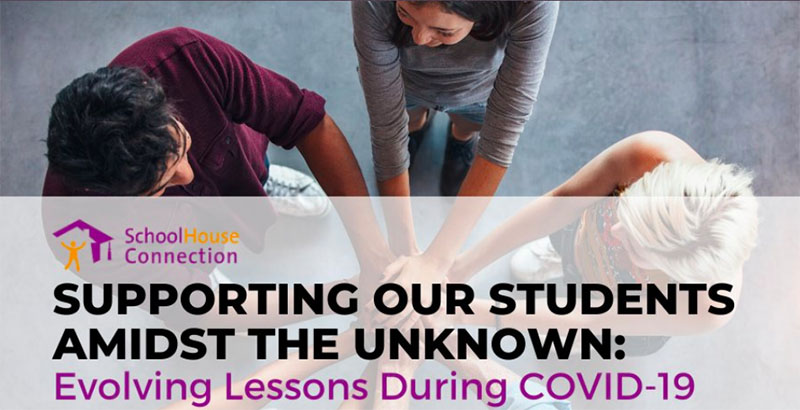The Realities of Life for Homeless Students Must Be Part of Remote Learning Strategies During Coronavirus Shutdowns

As our country continues to wrestle with the damaging effects of the coronavirus pandemic, and as school closures become the norm nationwide in an attempt to slow the spread, millions of students are dealing with uncertainty. Kids and families everywhere are facing difficult changes to their daily lives, but one group in particular is suffering profound loss from the systemic closure of our schools: children and youth experiencing homelessness.
For children and youth experiencing homelessness, schools are much more than classrooms. School is often the most stable and secure part of their day, a place that — quite unlike where they sleep at night — does not change. Early childhood settings and schools may also be their only source of food, education, health and mental health services, caring adults and safety.
Although we don’t know how long these closures will last, many schools have already stated that students won’t be allowed back until the fall. While educators and institutions continue to reassess their policies and make adjustments to ensure that disruptions are as minimally damaging as possible over the coming weeks and months, it’s critical that we center the experiences and realities of students who are homeless in response efforts.
Even before the coronavirus outbreak, student homelessness was a widespread and pervasive challenge. In New York City, the nation’s largest school district, with 1.1 million students, 1 in every 10 students experiences homelessness, and in Los Angeles, the second-largest district, some 17,500 students were counted as homeless in 2019. Across the United States in the 2017-18 school year, public schools identified 1.5 million children and youth experiencing homelessness, the highest number ever recorded and one that represents a population larger than the city of Dallas or the entire state of New Hampshire.
When schools and early learning programs close, the health, safety and well-being of these children and youth are jeopardized. Children and youth experiencing homelessness often stay in crowded, precarious situations with other people that make it impossible for them to self-isolate, or to recover should they fall ill. And moratoria on evictions don’t prevent families and youth from being kicked out when they are not on the lease, or from fleeing dangerous environments. Children and youth experiencing homelessness also often lack access to Wi-Fi or technology necessary for online learning, or a quiet, stable place in which to learn. In short, if school coronavirus initiatives are predicated on a stable and safe home environment, consistent internet access or reliable transportation, they will not reach these students.
At SchoolHouse Connection, we believe education is the only permanent solution to homelessness. Through strategic advocacy and practical assistance in partnership with early childhood programs, schools, higher education institutions and service providers, we aim to ensure that all children and youth experiencing homelessness have full access to quality learning so they will never be homeless as adults. Obviously, educators and schools are a crucial piece of this puzzle, but what does this look like on the ground in the middle of a global pandemic? There are a number of key steps that local education agencies and early childhood providers should take in the coming days, weeks and months to ensure that their responses are supporting those students most impacted.
It starts with identification and outreach: frequently reaching out to families and youth currently identified as homeless to determine their basic living situation, ensure that they’re receiving resources and information and let them know someone cares. Identify and communicate safe and stable housing options for quarantine/recovery, and where and how youth and families can access basic needs like food, health care and mental health services. Finally, prioritize making learning as accessible as possible during this outbreak. Consider accommodations like additional flexibility for deadlines and participation requirements for students who cannot participate in online learning opportunities. One of the greatest barriers that can prevent children and youth from participating fully in classes and school activities during remote learning is lack of access to technology. From providing free Chromebooks to all who request them in North Thurston, Washington, to purchasing thousands of mobile hotspots in New Orleans, to distributing free phones to students experiencing homelessness in Hernando County, Florida, on-the-ground efforts by schools and districts across the country are helping to fill this vital gap.
During this time of great upheaval, the stark realities of students experiencing homelessness and the vital supporting role of educators and schools has been made crystal clear. Our pandemic responses must proactively prioritize outreach to homeless families and unaccompanied youth. Now more than ever, we must address this crisis with child- and education-centric solutions that work for all students, no matter their personal circumstances. Our children and youth are counting on us.
Barbara Duffield is the executive director of SchoolHouse Connection, a national nonprofit organization working to overcome homelessness through education.
Get stories like these delivered straight to your inbox. Sign up for The 74 Newsletter

;)
